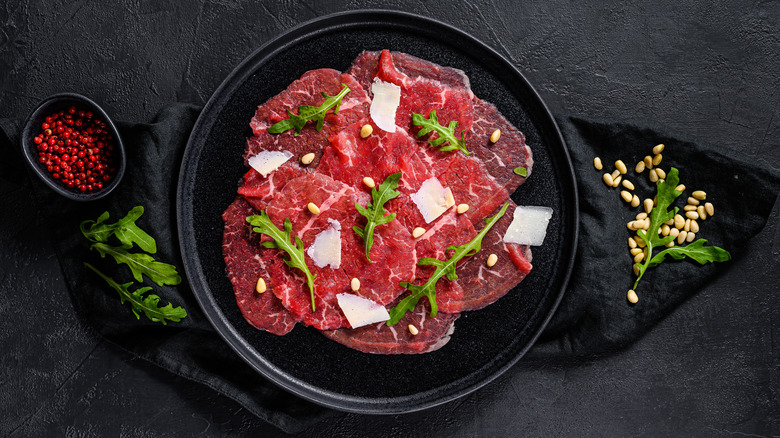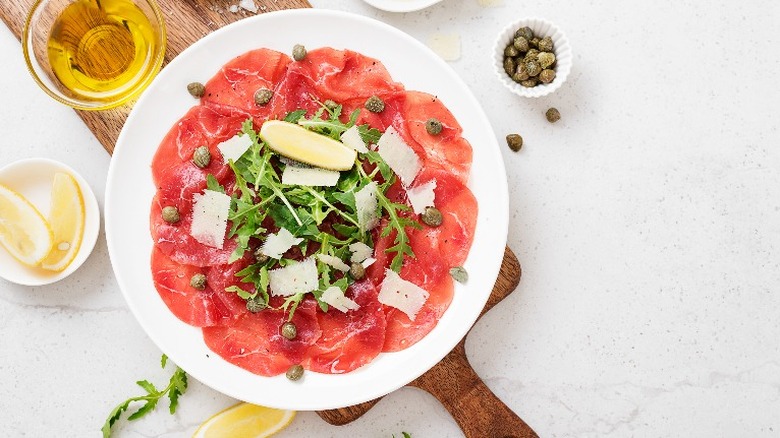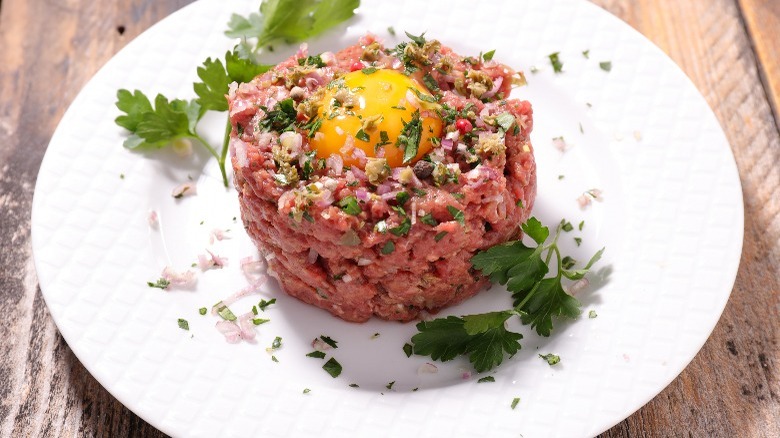What's The Difference Between Carpaccio And Tartare?
While it's usually not recommended to eat raw meat, the right preparation of a fresh steak can make uncooked beef a downright delight. Various cultural cuisines around the globe feature raw meat dishes, with the most familiar ones likely being carpaccio and tartare. These special dishes often make their way onto the appetizer menus of high-end restaurants, though one shouldn't confuse them. Both are served raw, but carpaccio is thinly sliced, while tartare comprises small pieces akin to minced beef.
Technically speaking, there's always a risk when consuming raw meat, so those who get a bit squeamish at the idea or are more susceptible to infections will most likely avoid both of these menu options. Luckily, the types of restaurants that serve both carpaccio and tartare are usually the sort to purchase high-quality meat that's at a lower risk of carrying food-borne bacteria. They may also maintain a dedicated sanitized section in the kitchen where separate, clean utensils are used to minimize cross-contamination.
Conversing about carpaccio
Despite the Italian nomenclature of "carpaccio," the dish's history also has American links. The delicacy's birthplace is a Venice restaurant called Harry's Bar, which is still operating to this day as a historical landmark. Owner Giuseppe Cipriani named the spot after his American friend Harry Pickering, and it serves as a popular watering hole for celebrities from Jimmy Stewart to George Clooney. Carpaccio got its start in 1963, when a countess from the Venetian noble house of Mocenigo asked Cipriani to indulge her in a meat dish. The catch? Under her doctor's orders, she couldn't consume any cooked meat.
The chef's solution was to cut up a couple of slices of raw beef and drizzle them with mayonnaise and Worcestershire sauce. Cipriani admired the red and white hues of the dish and named his creation after another artist, the Renaissance painter and fellow Venetian Vittore Carpaccio. The white in carpaccio nowadays is often Parmesan cheese, accompanied by olive oil, capers, and arugula. Modern carpaccio also comes in different forms like tuna, lamb, and even fruits and vegetables for vegans and vegetarians. Interestingly enough, Cipriani's main inspiration for carpaccio came from another Italian dish called carne cruda all'Albese, which shares more in common with its French cousin, steak tartare.
Talking about tartare
The origins of tartare date further back than the relatively recent carpaccio, shrouding its past in somewhat of a mysterious cloak. Its name sounds like it hearkens back to the Tatars, one of the Mongolian steppe tribes that joined the army of Genghis Khan. Legend has it that these fearsome warriors dined on raw horse meat that they tenderized under their saddles. Although the Mongols did eat horse meat, it was a rare delicacy reserved for high-ranking leaders, and the saddle meat was most likely to cushion their horses' sores.
Culinary historians have theorized that the dish may have roots in Poland and Polynesia, and the French chefs who put the dish on their menus in the late 19th century served it in the style of steak à l'américaine. Whatever the exact lineage of steak tartare is, the meal is a celebration of all that is uncooked, consisting of a minced beef patty seasoned with ingredients like onions, capers, and sauces like Worcestershire and Tabasco, all topped with a raw egg yolk. Tartare is so delicate that chefs chop meat into tiny pieces instead of throwing it in the grinder, but the result resembles ground beef more than the paper-thin slices of carpaccio. In fact, the whole dish is quite distinct from carpaccio besides its rawness and some of its flavorings, but both offer a delicious alternative to cooked meat if you're willing to be a little more adventurous.



